Tired of endless lawn work and high water bills for a patchy yard? The perfect lawn seems impossible. Many are now switching to a beautiful, low-maintenance artificial grass solution.
Customers choose artificial grass for its low maintenance, long-term cost savings, and consistent appearance. It eliminates watering, mowing, and fertilizing. This saves time and money, providing a durable, beautiful green space year-round, regardless of weather conditions. It’s a practical solution for modern lifestyles.
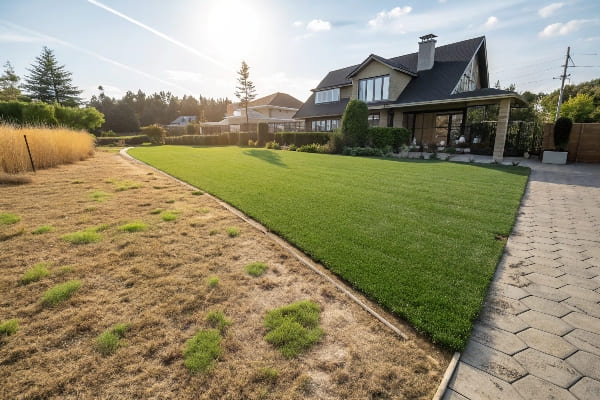
The shift towards artificial grass is becoming more and more obvious. I see it every day in my work helping customers find the right solutions for their projects. But what really makes one better than the other? It is not just about looks. Many factors like cost, maintenance, and durability come into play. For years, I’ve helped clients weigh these options. People often ask me for a simple breakdown of the facts. So, let’s dive into the details to help you make the best choice for your needs.
Which is better, artificial grass or natural grass?
Deciding between a real lawn and artificial turf feels confusing. You worry about making the wrong long-term choice. Let’s compare them directly to find the best fit for you.
"Better" depends on your priorities. Natural grass is traditional and great for the ecosystem. Artificial grass excels in low maintenance, durability, and year-round perfection. For busy people or high-traffic areas, artificial grass is often the more practical and cost-effective choice over its lifetime.
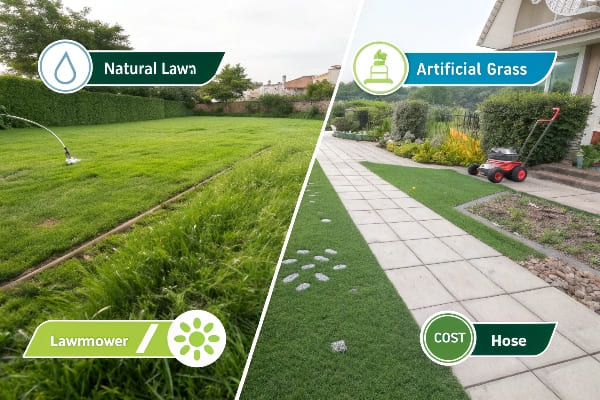
In my experience as an engineer, the choice is not about "good" versus "bad." It is about finding the right material for the right job. I have guided many clients through this exact decision. To make it clear, let’s break down the key differences in a way that is easy to understand.
Long-Term Costs1
I always tell my clients to look beyond the initial price tag. Natural grass seems cheaper at first. You just need seeds or sod. But then you have costs for water, fertilizer, pesticides, and equipment like lawnmowers. These costs add up every year. Artificial grass has a higher upfront installation cost. However, after that, your expenses are almost zero for many years.
Maintenance and Usability2
This simple table helps show the full picture. For a business owner with a large sports field, the savings on water and maintenance for artificial grass are huge over a decade.
| Feature | Natural Grass | Artificial Grass |
|---|---|---|
| Initial Cost | Low | High |
| Maintenance Cost | High (water, mowing, feed) | Very Low (rinsing) |
| Water Usage | High | Almost None |
| Durability | Wears out in high traffic | Very High |
| Appearance | Varies with weather/season | Consistently Green |
Pros and Cons of Artificial Grass?
You hear great things about artificial grass but worry about the downsides. Is it too good to be true? Let’s look at both sides for a balanced, honest view.
The main pros are minimal maintenance, water conservation, and a perfect look year-round. It is also durable and allergen-free. The cons include a higher initial cost, heat absorption in direct sun, and the fact that it is a manufactured product, not a natural ecosystem.
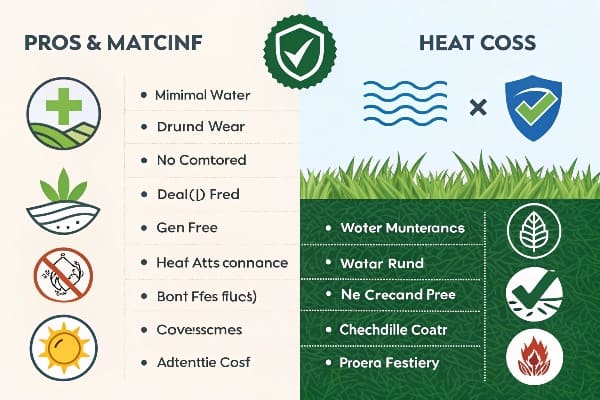
As someone who has worked in this industry for a long time, I believe in being transparent. No product is perfect for every single situation. Understanding the full list of pros and cons is key to making a confident decision. I always make sure my clients understand the complete picture, both good and bad, before they buy. This builds trust and ensures they get a product they are happy with for years.
The Big Advantages (The Pros)
First, you save an incredible amount of time and money. Think about all the hours spent mowing, weeding, and watering a natural lawn. Artificial grass gives you that time back. For the commercial projects I often supply, this means huge savings on labor and water bills. Second, it is always ready to use. After it rains, a natural lawn is a muddy mess. An artificial field drains quickly and is ready for play almost immediately. This is critical for sports facilities that cannot afford downtime.
Things to Consider (The Cons)
The biggest hurdle for most is the upfront investment. The initial cost is higher than seeding a lawn. However, I frame it as an investment that pays for itself over time through savings. Another point is heat. The surface can get warmer than natural grass in direct, intense sunlight. However, new technologies, which we call "cool yarn" technology, are reducing this effect significantly. Using a light-colored sand infill also helps a lot. It is an important factor to consider, especially in hot climates.
Is Artificial Grass Environmentally Friendly?
You want a green lawn but also want to protect the planet. Does artificial grass help or harm the environment? Let’s examine the real environmental impact of this choice.
It’s a complex issue. Artificial grass saves massive amounts of water and eliminates the need for chemical pesticides and fertilizers, protecting local water sources. However, it is a plastic product derived from fossil fuels and its disposal needs consideration. The overall impact depends on various factors.
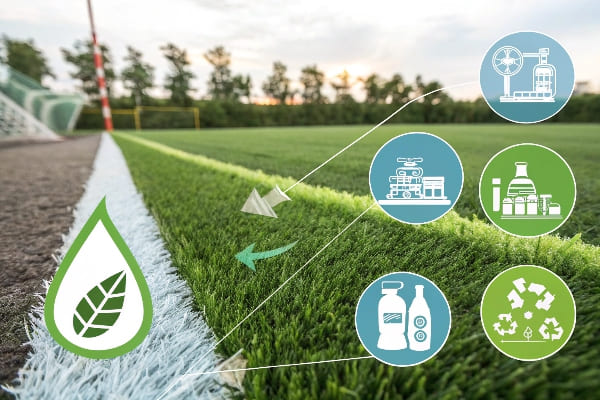
This question comes up a lot in conversations with my clients. People are rightly concerned about the environment. I have spent years on the technical side of production, so I can share some direct insights. The answer is not a simple "yes" or "no". It has both positive and negative environmental aspects that you should weigh.
The Environmental Wins
One of the biggest benefits is water conservation. In very dry regions, this is a massive advantage. A single natural grass sports field can use millions of gallons of water a year. Artificial turf uses almost none. This is a huge positive. Also, you stop using harmful chemicals. No more fertilizers or pesticides running off into the groundwater and local rivers. This is a big win for local ecosystems and water quality.
The Environmental Challenges
On the other hand, we have to be honest. Artificial grass is made from plastic, which uses petroleum. The manufacturing process has a carbon footprint. And at the end of its long life, recyclability can be a challenge, although the industry is making huge progress here. Many components, like the backing and yarn, can now be recycled. At QH Grass, we are constantly looking for more sustainable materials and production methods. It is our responsibility to the industry and our planet.
Why is artificial grass so popular?
Suddenly, artificial grass is everywhere, from backyards to professional stadiums. You wonder what is driving this big trend. Let’s uncover the simple reasons behind its massive popularity today.
Its popularity comes from a perfect match with modern lifestyles. People have less time for yard work and want practical, beautiful solutions. Technological advances have made turf look and feel more realistic than ever, while its cost-effectiveness and durability make it a smart long-term investment.
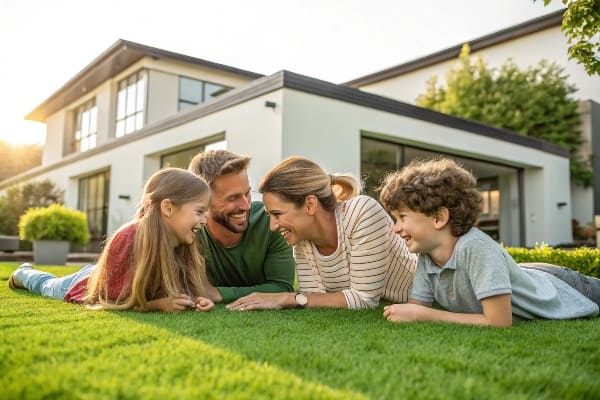
From my perspective as a supplier, I have seen the demand explode over the last decade. It’s not just one thing; it is a combination of factors that just make sense for a lot of people and businesses today. The reasons are a mix of practicality, technology, and smart economics.
A Solution for Modern Life
Life is faster now. People value their free time. The idea of spending every weekend maintaining a lawn is less appealing. Artificial grass offers a "set it and forget it" solution. You get a perfect lawn without the constant work. This fits perfectly with busy families, working professionals, and commercial property owners who need their spaces to look good without constant expense.
Technology Makes It Better
Early artificial turf looked like a green plastic carpet. I remember those days well from my time in the workshop. Today’s products are completely different. We now use multiple colors of yarn, different blade shapes, and soft materials to make it look and feel incredibly real. From a technical standpoint, the improvements in UV stability, drainage technology, and durability are huge. People are choosing it because it’s now a high-quality, realistic product that performs incredibly well.
Conclusion
Artificial grass offers a low-maintenance, durable, and cost-effective solution for modern needs. It provides a consistently perfect look, saving time, water, and money over the long term.
_画板-1.png)
_画板-1.png)